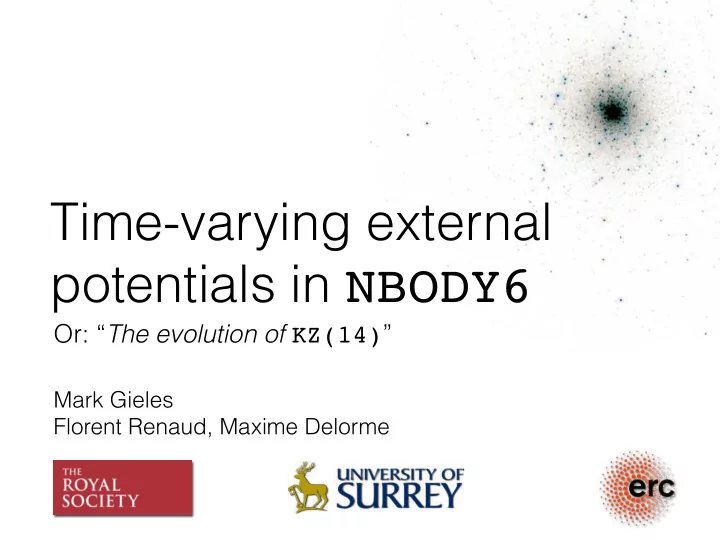

Time-varying external potentials in NBODY6 Or: “ The evolution of KZ(14) ” Mark Gieles Florent Renaud, Maxime Delorme
Evolution without tides KZ(14)=0 Baumgardt, Hut & Heggie 2002
Odenkirchen+ 2002
Agertz & Kravtsov Horizon simulation (Teyssier et al.)
Existing methods: NBODY5 Solve EoM in rotating reference frame §8.5-8.6 e.g. Oh, Lin & Aarseth 1992 y R I Galactic centre r x cluster tidal Coriolis centrifugal Euler r = �r φ c + ¨ R I � ¨ r � Ω ⇥ ( Ω ⇥ r ) � ˙ ¨ R I0 � 2 Ω ⇥ ˙ Ω ⇥ r Pro: numerical accuracy Con: work out (linearised) terms for each ! G
Existing methods: NBODY6 Solve EoM in rotating reference frame §8.5-8.6 e.g. Giersz & Heggie 1997 cluster Coriolis tidal+centrifugal Euler r + Ω 2 (3 x e x � z e z ) r = �r φ c � 2 Ω ⇥ ˙ ¨ KZ(14)=1: Galactic disc (Oort constants) KZ(14)=2: Point-mass galaxy Pro: numerical accuracy, conserved Jacobi energy E J Con: circular orbits, derive (linearised) terms & for each ! G j ≡ ... r
Existing methods: NBODY6 Solve EoM in non-rotating (accelerating) frame §8.5-8.6 e.g. Baumgardt & Makino 2003; Hurley+; Küpper+ cluster tidal y Galactic centre r = �r φ c + ¨ R I � ¨ ¨ R I0 x KZ(14)=3: 4 component Galaxy model: 1. Miyamoto - Nagai disc y 2. (singular) isothermal halo 3. Dehnen/Tremaine bulge x 4. Central point-mass (i.e. black hole) Pro: all orbits, (relatively) easy to sum components Con: work out tidal terms & j for each ! G , time independent ! G
Existing methods: NBODY6 KZ(14)=3 §8.5-8.6 Note on energy conservation: Renaud & Gieles 2015a; Heggie priv. comm.
Existing time-varying potential NBODY6 KZ(14)=4 Background time dependent Plummer (1911) potential “gas expulsion” e.g. Kroupa++
Time-varying potentials: NBODY6tt https://github.com/florentrenaud/nbody6tt KZ(14)=9 “Mode A”: Renaud, Gieles & Boily 2011 cluster tidal r = �r φ c + T tid · r ¨ T tid = − ∂ 2 φ G Tidal tensor: ∂ x i ∂ x j Pro: ! G can be anything Con: linearised tides, not good for streams
Time-varying potentials: NBODY6tt https://github.com/florentrenaud/nbody6tt KZ(14)=9 “Mode A”: Renaud, Gieles & Boily 2011 How it works: • ttinit.f: reads tdal tensor file tt.dat (time + 9 TT components) • ttcal.f: quadratic interpolation of TT in time, get TT derivative •Some changes to xtrnlf.f: see also: http://personal.ph.surrey.ac.uk/~fr0005/nbody6tt.php
Test Mode A NBODY6tt KZ(14)=9 vs KZ(14)=3
A T ALE OF T WO C LUSTERS Renaud & Gieles (2013)
Time-varying potentials: NBODY6tt KZ(14)=9 “Mode B”: Renaud & Gieles 2015a ! G can have any dependence on space and time! cluster tidal r = �r φ c + a G ( r , t ) � a G0 ( r , t ) ¨ Pro: ! G can be anything, external forces not linearised: streams Con: analytical expression for ! G ( r ,t )
NBODY6tt: KZ(14)=9 “Mode B”
Stepsize h i (Press+ 2007) For fourth order: ✏ = machine precision (~10 -16 ) ⇣ = 1/5 ◆ 1 / 5 ✓ � G = curvature scale x c = @ 5 � G / @ x 5
Stepsize h i F reg precision (GPU) F irr precision (CPU)
NBODY6tt: KZ(14)=9 “Mode B” How it works: •Computation galactic force and its derivative: ttforce.f (comparable to ttfnuc.f, fhalo.f, etc.) •User defined ! G ( r ,t ): ttgalaxy.f
Test Mode B NBODY6tt KZ(14)=9 (Mode B) vs KZ(14)=3 Dissolution in point-mass galaxy Disc crossing
T HREE T IDAL H ISTORIES Static potential Growing potential Static potential z = 5 5 > z > 0 z = 0 not really used most realist one most often used
N BODY 6 TT R UNS Time-dependent Static (z=0) R ENAUD & G IELES 2015 B
N BODY 6 TT R UNS 500 pc Time-dependent Static (z=0) R ENAUD & G IELES 2015 B
N BODY 6 TT R UNS 500 pc Time-dependent Static (z=0) R ENAUD & G IELES 2015 B
Agertz & Kravtsov Horizon simulation (Teyssier et al.)
Recommend
More recommend